
Andalusia is the southernmost autonomous community in Peninsular Spain, located in the south of the Iberian Peninsula, in southwestern Europe. It is the most populous and the second-largest autonomous community in the country. It is officially recognised as a historical nationality and a national reality. The territory is divided into eight provinces: Almería, Cádiz, Córdoba, Granada, Huelva, Jaén, Málaga, and Seville. Its capital city is Seville, while the seat of its High Court of Justice is the city of Granada.

Almería is a province of the autonomous community of Andalusia, Spain. It was named after the Arab ruler of Taifa, Banu Al-Miri. It is bordered by the provinces of Granada, Murcia, and the Mediterranean Sea. Its capital is the homonymous city of Almería.

Granada is a province of southern Spain, in the eastern part of the autonomous community of Andalusia. It is bordered by the provinces of Albacete, Murcia, Almería, Jaén, Córdoba, Málaga, and the Mediterranean Sea. Its capital city is also called Granada.

In Spain, a comarca is either a traditional territorial division without any formal basis, or a group of municipalities, legally defined by an autonomous community for the purpose of providing common local government services. In English, a comarca is equivalent to a district, county, area or zone.

Manilva is a municipality which lies on the coast at the southwesternmost edge of the province of Málaga on its border with the Province of Cádiz in the autonomous community of Andalusia in Spain. It belongs to the comarca of Costa del Sol Occidental.
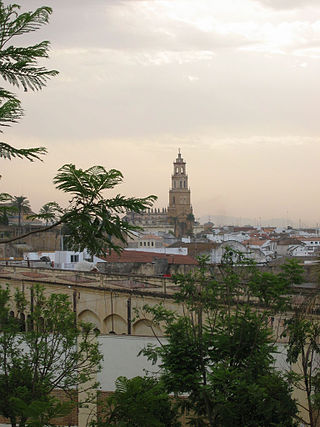
Utrera is a municipality in south-west Spain. It is in the province of Seville, in the autonomous community of Andalusia. As of 2018 it has a population of 52,617.

Baza is a town in the province of Granada in Andalusia, twice a former Catholic bishopric and now a Latin Catholic titular see as Basti.

Montefrio is a municipality in the province of Granada. The ruins of a Moorish castle sit near the highest point. Being built midway between the Sierra de Priego and Sierra Parapanda, and commanding the open valley between these ranges, it became one of the chief frontier fortresses of the Moors in the 15th century.

Ajoblanco is a popular Spanish cold soup typical from Granada and Málaga (Andalusia). This dish is made of bread, crushed almonds, garlic, water, olive oil, salt and sometimes vinegar. It is usually served with grapes or slices of melon. When almonds were not available, for instance during the post-war period, flour from dried beans was used.

The Penibaetic System is the southernmost of the three systems of mountain ranges of the Baetic System in the southern Iberian Peninsula. It includes the highest point in the peninsula, 3,478 m high Mulhacén in the Sierra Nevada.

Cómpeta is a town and municipality in the comarca of Axarquía, and province of Málaga, part of the autonomous community of Andalusia in southern Spain. The municipality is situated approximately 18 kilometres from the coast, and 52 kilometres from Málaga, the provincial capital. It is situated at 638 metres above sea level in the foothills of La Maroma. The population is spread over the southern slopes of the Sierra de Almijara.

Cuevas de San Marcos is a town and municipality in the province of Málaga, part of the autonomous community of Andalusia in southern Spain. The municipality is situated in the northern part of the Antequera region, on the border of the province of Córdoba from the river valley of Genil to the Sierra Malnombre and Camorro de Cuevas Altas. It is also located within the comarca of Nororma. It borders the provinces of Granada and Cordoba to the north, the comarcas of La Axarquía to the south and Antequera to the west. The town is situated at an altitude of 420 meters above sea level.
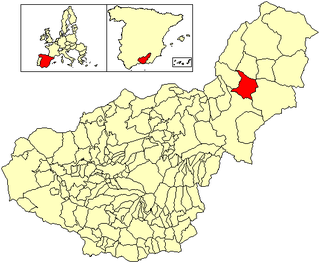
Benamaurel is a village located in the province of Granada, Spain. According to the 2006 census (INE), the city has a population of 2328 inhabitants. The municipality includes the following localities: Puente Arriba, San Marcos, Cuevas de la Blanca, Huerta Real, Cuevas del Negro y Cuevas de Luna. There is a market held every Sunday morning and a 3-day Moors and Christians festival held in April.

Altiplano de Sierra Nevada is a Spanish geographical indication for Vino de la Tierra wines located in the autonomous region of Andalusia. Vino de la Tierra is one step below the mainstream Denominación de Origen indication on the Spanish wine quality ladder.

The Hoya of Baza is a valley in the northern part of the province of Granada, Andalusia, southern Spain, named after the town and former bishopric Baza, Granada. It is one of the series of valleys forming the Surco Intrabético.
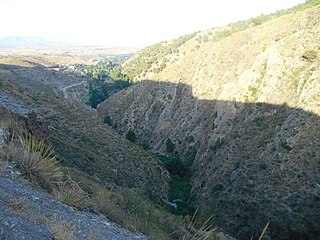
The Almanzora River is a river in the province of Almería in Andalusia, Spain.
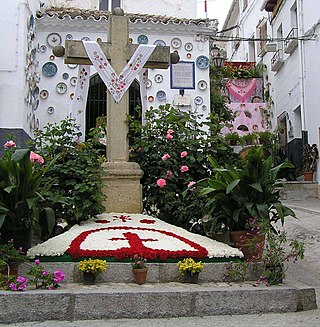
The Fiesta de las Cruces or Cruz de Mayo is a holiday celebrated on 3 May in many parts of Spain and Hispanic America.

Arenas is a municipality in the province of Málaga located in the autonomous community of Andalusia in southern Spain. It is situated in the comarca of Axarquía. By way of road it is located 12 kilometers from Vélez-Málaga, 50 km from Málaga and 577 km from Madrid. It is located northwest of the Axarquia, between the sierras of Tejeda and Almijara and the Castle of Bentomiz.
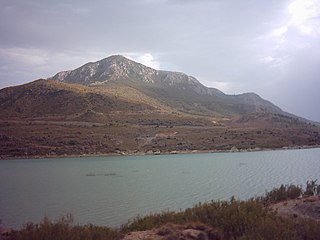
Negratín Reservoir is a reservoir located in Freila, province of Granada, Andalusia, Spain and it is considered one of 11 other reservoirs in Granada.

Comarca de Baza is a comarca in the province of Granada, Spain. It contains the following municipalities:























